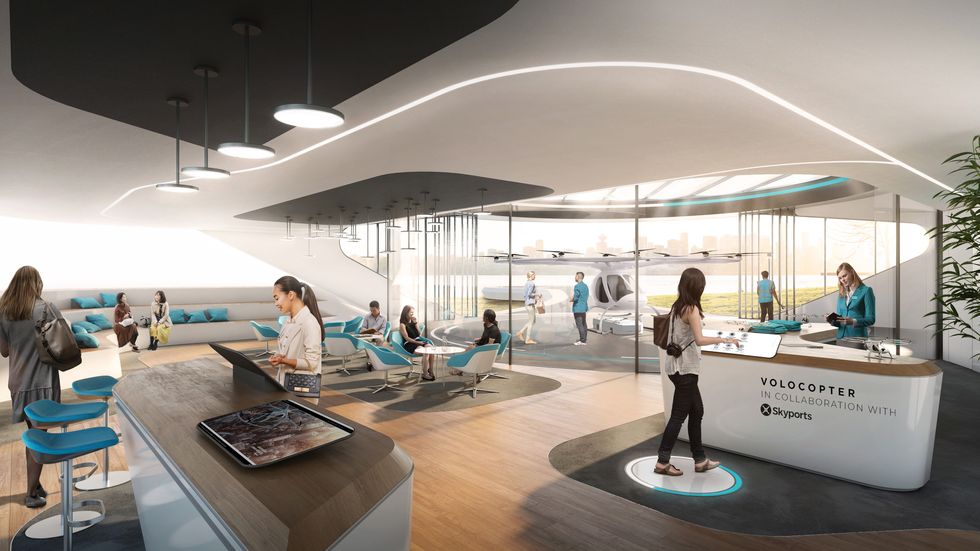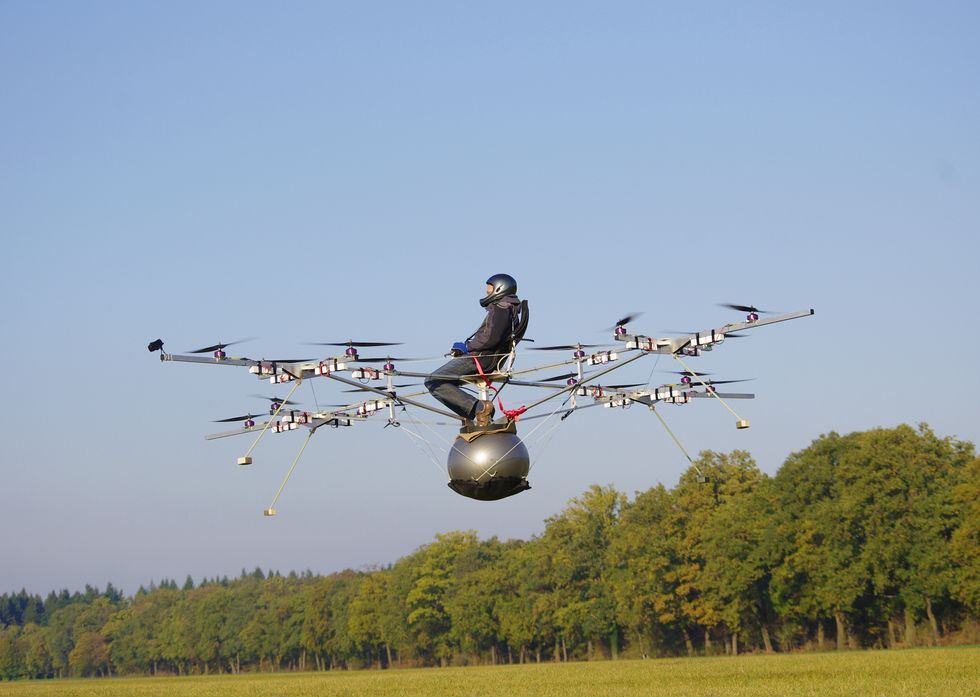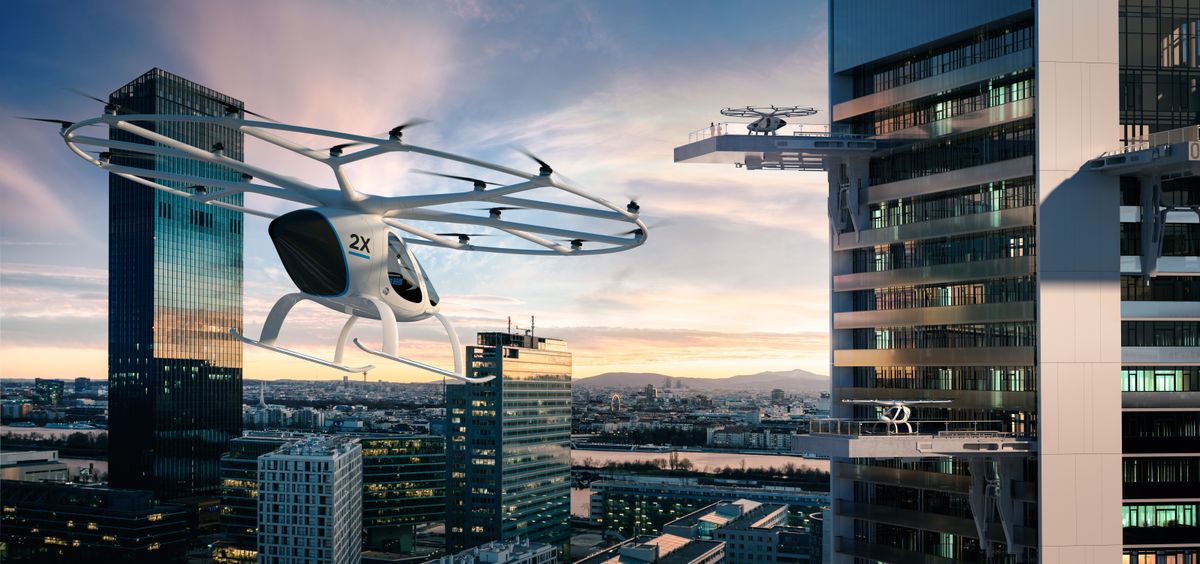Eight years ago, when Alex Zosel cofounded his start-up, the idea of electric air taxis seemed completely crazy. Today, however, some cities are already testing them. Volocopter's founder explains why urban transport should turn to the sky and how his start-up wants to become more than just an aircraft manufacturer.
Alex Zosel, how will urban mobility evolve?
Urban mobility will undergo a huge transformation in the next 20 to 30 years. Following an already perceptible trend, private means of transport will be increasingly chosen for environmental reasons (efficiency, low emission...) rather than for ego-boosting (power, speed...). Many new devices will appear or co-exist: we will see cable cars, e-scooters, conveyor belts, streets dedicated to fast bikes, etc. This evolution will certainly also depend on the evolution of society and work. New technologies could very well reduce working hours, the workforce, increase teleworking – all this will have an impact on traffic.

We believe that in megacities with saturated roads and major traffic flow issues, the only viable solution will be the sky! We want to be one of the big players, one of the drivers in urban air mobility. This is why we talk a lot about the transformation of cities with architects and infrastructure specialists. On the one hand, we are thinking in the long term – imagining a future with thousands of aircraft in the city skies. On the other hand, in the short term, the first solutions, the first missions: where are the current needs for flying taxis? Where would they really make a positive impact in terms of mobility? It is on these short-term solutions that we will gradually build up the ecosystem of urban air mobility.
Which missions are you focusing on first?
On combating bottlenecks in megacities. They represent a highly critical situation that flying taxis could rapidly improve. For instance, by transporting people between airports and city centres, or between tourist attractions – an issue in a large number of cities. It wouldn't be necessary to transport everyone through the skies, but relieving some roads could rapidly help the whole system to flow better.
Short hops and no long-distance commuting, unlike the market targeted by the Uber Elevate system?
We want to fly between cities one day, but we believe that flying in inner cities would fix a more urgent problem. There is also a technological reason for this choice: we want a reliable solution now, using tried and tested, already existing batteries, which do not provide for flying over long distances. The limited range of our aircraft – 35km – is not a problem: our analysis shows that 90% of the megacities we are targeting have a major airport within 30km of the city centre. Therefore, millions of journeys are within our reach.
Your targeted mission also influences some other design aspects of your solution...
Our aircraft is fully designed for this mission. Its extensive propulsion system including 18 engines, for example, makes it extremely quiet and reliable (it can fly even if several engines aren't functioning). Noise and safety are the major criteria for being approved in cities. Our speed of 110km/h is also important: flying twice as fast would be terrifying, dangerous, much noisier and, considering the short distances, it wouldn't really be a time-saver.
Are eVTOLs appropriate from the environmental point of view?
They are zero emission which is already great. Obviously, they require more energy for taking off than a car on a flat surface. On the other hand, there is no need to build roads, bridges, tunnels – all these costly infrastructures which then generate huge maintenance costs. If you add the impact of these infrastructures to the impact of vehicles, it is clearly more efficient to go up into the sky! Slowing down or decreasing the development of the road network also makes it possible to save or reintroduce nature into cities.
Launching innovative new means of transport is often hindered by the rules which have to be created or adopted...
Integrating this aspect is part of Volocopter's DNA: we have been discussing with the authorities for over 7 years about how to integrate eVTOLs. In general, the authorities are fairly open: they want to make flights safer, which is exactly what sensors and automated systems built in the heart of eVTOLs provide for. We have been partners of the European Aviation Safety Agency (EASA) for two years. We have helped to integrate air taxis flying in inner cities – which could also fly autonomously – in these regulations. Similarly, we have been working with the US Federal Aviation Administration, whose processes are somewhat more complex and extensive. The “Special Condition for VTOL" of the EASA was presented in early July and we are very proud to have contributed to it. The VoloCity, our new aircraft, will be the first commercially licensed Volocopter accredited to these high standards and requirements. Simply put, the safety requirements are that flying taxis will have to be as safe as commer- cial aircraft. They shall be.
How about integration in air traffic?
This is more of a local thing: the selection of routes, weather conditions, altitudes, coexistence with drones and helicopters... Again, we have a lot of experience, namely thanks to our cooperation with the Dubai government's Roads and Transport Authority. They asked us to participate in a project for autonomous flying devices in the airspace over their city. The feasibility of such a service was proven after a successful test with our Volocopter 2X in September 2017. This was the first-ever public flight of an autonomous urban air taxi. We are currently working with Singapore authorities, who are also interested.
So, it is city by city that Volocopter develops its projects?
Yes. Many cities have already asked us to become technical partners to advise on how to develop urban air mobility infrastructures and services. Therefore, they are motivated and very much involved. They dedicate the necessary resources and it can quickly go forward – we have no fear of not getting approvals. We start off with a first route from A to B, as a first step. Whatever happens afterwards, Volocopter can always learn a lot and it helps us to extend our offer.
Do you also work with airport operators, such as Skyport?
Yes, indeed.Not only for the integration of air taxis in their territory, but also for integrating our services with theirs.

We could imagine for instance that check-in for an international flight would be possible upon embarking at a vertiport in the city. It would relieve traffic in their departure area.
The way you describe it, it would seem that Volocopter will provide services, rather than just aircraft...
You are exactly right. From the beginning, we never wanted to be a manufacturer of vehicles. We want to be a mobility provider, to sell the tickets. Everything beneath that is based on very strong local partnerships, with the authorities, real estate players, airport operators or helicopter companies, whose launch pads we could use. In a nutshell, we have to associate with all of those to ensure the smooth integration of flying taxi services in a city. At the same time, our vertiport projects are not exclusive: other eVTOLs could also use them. Volocopter could even buy or rent aircraft from other manufacturers. We are really open – we wouldn't be able to create an air-mobility system if we were exclusive. Our eVTOLs have a head-start, so we will start with them to be the first on the market. Then we will see how to increase the scale.
When will these air taxis be part of our daily lives?
They have been part of my daily life for years, since I am one of the test pilots! I think the first regular route will be opened in 2 to 3 years. The speed of their implementation will depend on several factors, including the production capacity of eVTOL manufacturers! By the time I retire in 13 years, we should have a system of flying taxis in at least 10 mega– cities. If not, well, in that case I will have to retire five years late!
From a small drone to flying taxis, the Volocopter history

The VC1 proved in October 2011 that an electric multicopter was capable of taking off vertically with a passenger. Then, the first prototype, the VC200, was suitable for carrying 2 people. It made its first manned flight – with Zosel himself as the pilot – in March 2016. The VC200 had been financed through an instantly successful online crowdfunding (500,000 euros in 2 hours and 35 minutes!).
This model also marked a major milestone: it got a license to fly all over the country from the German authorities. The Volocopter 2X, first displayed in 2017, has since been built into a miniseries for extensive test flights in manned, unmanned (which includes remote-controlled), and automated (following a preset route with no human interference) configurations.
In only 8 years, the seemingly absurd idea of a “drone for humans" has become a certified aircraft. In the meantime, eVTOL aircraft (electric vertical take-off and landing) have generated an industrial race (see page 08). Volocopter, a visionary? In any case, that's how the World Economic Forum seems to consider the startup, as they were among the winners of the 2019 “Technology Pioneer" award which recognises companies that are “poised to have a significant impact on business and society".
Many investors, large and small, have contributed so far to financing Volocopter, including Daimler and Intel. Lukasz Gadowski, a German serial entrepreneur and founder of Circ (formerly known as Flash) micro mobility electric scooter, is one of the personalities who have been convinced. Last September, Geely, the Chinese Group owner of Volvo and Lotus cars, as well as Terrafugia (hybrid cars/aircraft) headed the round of private funding amounting to 50 million euros for the C Series.
This summer, Volocopter presented its next model, the VoloCity (for all the details, see page 14). Slightly larger and twice as heavy and powerful as the 2X, this multicopter is not a prototype, but rather the first to be marketed.
The startup, with a current staff of about 150, aims at becoming a mobility provider (see the interview with Alex Zosel, page 10). It has been working for several years already with Dubai and Singapore, who have requested a feasibility study on such services in their skies.
At the end of October, Volocopter conducted a public proof of concept flight in Singapore. It also displayed a vertiport prototype there, not for launching the eVTOLs (the authorisations are missing), but for testing and improving various services (reception, booking, check-in). This proof of concept on a one-to-one scale is another step towards the imminent launching of a brand new type of urban mobility.



